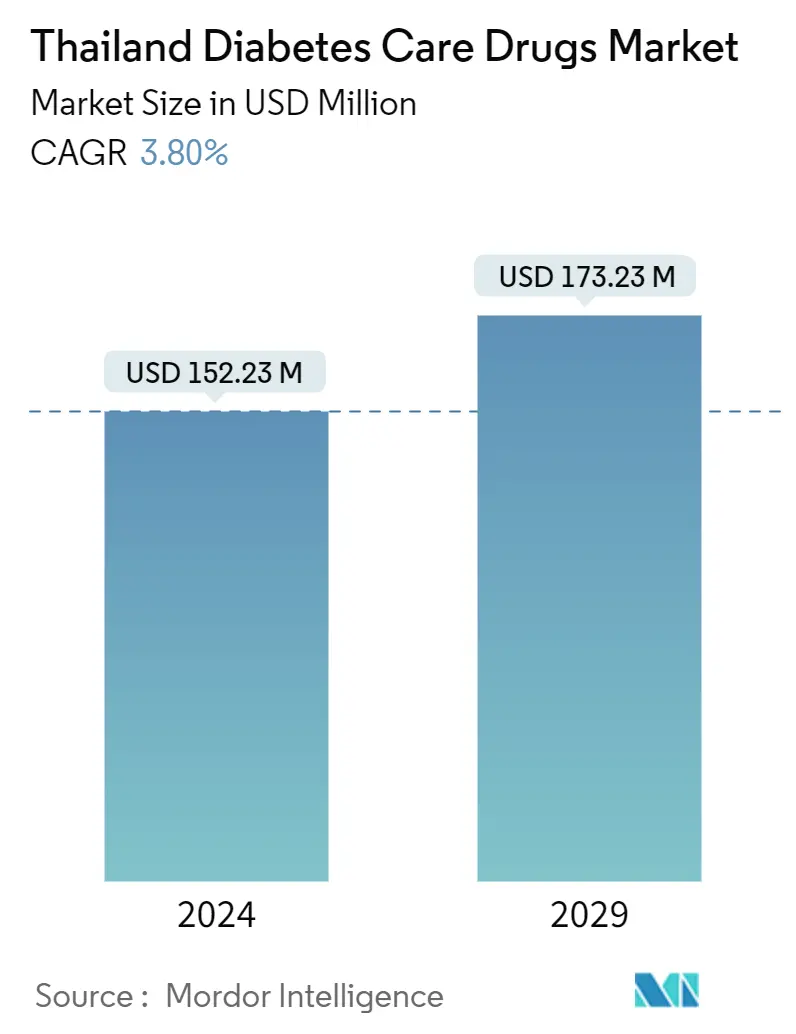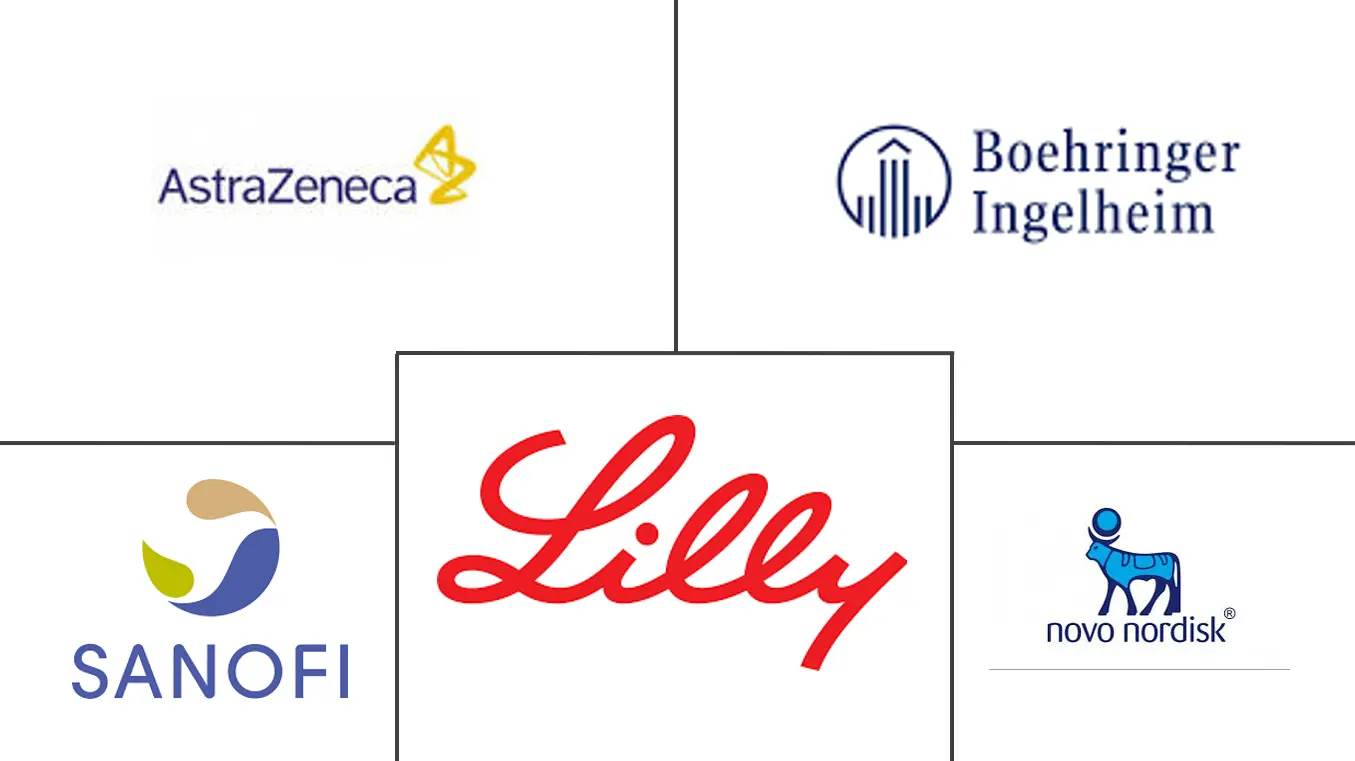Market Size of Thailand Diabetes Care Drugs Industry

| Study Period | 2019 - 2029 |
| Base Year For Estimation | 2023 |
| Forecast Data Period | 2024 - 2029 |
| Market Size (2024) | USD 152.23 Million |
| Market Size (2029) | USD 173.23 Million |
| CAGR (2024 - 2029) | 3.80 % |
Major Players
*Disclaimer: Major Players sorted in no particular order |
Thailand Diabetes Care Drugs Market Analysis
The Thailand Diabetes Care Drugs Market size is estimated at USD 152.23 million in 2024, and is expected to reach USD 173.23 million by 2029, growing at a CAGR of 3.80% during the forecast period (2024-2029).
The healthcare system was significantly disturbed and pressured during each phase of rapid COVID-19 infection. Several countries, notably the Thai government, introduced home isolation or a home quarantine program to avert healthcare collapse and to ameliorate inadequate healthcare resources. Between July 2021 and October 2021, COVID-19 illness cases in Thailand increased to around 20,000-25,000 cases per day, posing difficulty in treating COVID-19 infection in hospitals. Previous research revealed the viability of a COVID-19 home monitoring program employing telemedicine to reduce the gap in treatment during a healthcare worker shortage in multiple countries. These programs monitored the intensity of symptoms and informed patients to seek additional treatment if necessary.
During COVID-19, there was a shortage of hospital capacity, and a home isolation system was set up. Thailand's government introduced diabetes self-management education and support (DSMES, glycemic management via telemedicine, and outcomes in home-isolated patients with COVID-19 infection. In August 2022, The National Research Council of Thailand (NRCT) introduced a breathalyzer prototype that can detect those infected with COVID-19 with 97% accuracy.
In terms of medicines, the insulin category commands a sizable market share. Over 100 million people worldwide use insulin, including all persons with Type 1 diabetes and 10% to 25% of people with Type 2 diabetes. Insulin production is extremely sophisticated, and only a few manufacturers are on the market. As a result, there is fierce rivalry among these producers, who continually strive to satisfy patients' demands by providing the highest-quality insulin.
Thailand Diabetes Care Drugs Industry Segmentation
Diabetes or diabetes mellitus describes a group of metabolic disorders characterized by a high blood sugar level in a person. With diabetes, the body either does not produce enough insulin or the body's cells do not respond properly to insulin, or both. Thailand's diabetes care drugs market witnessed usd 532 million in the current year and is anticipated to register a cagr of over 1% during the forecast period. Thailand's diabetes care drugs market is segmented into drugs (oral anti-diabetic drugs, insulin, non-insulin injectable drugs, and combination drugs). The report offers the market size in value terms in usd for all the abovementioned segments.
| Oral Anti-diabetic drugs | ||||||
| ||||||
| ||||||
| ||||||
| ||||||
| ||||||
| ||||||
|
| Insulins | |||||||
| |||||||
| |||||||
| |||||||
|
| Combination drugs | |||||
| |||||
|
| Non-Insulin Injectable drugs | |||||||
| |||||||
|
Thailand Diabetes Care Drugs Market Size Summary
The Thailand diabetes care drugs market is poised for growth, driven by a combination of factors including government initiatives and advancements in medical technology. The market is characterized by a significant focus on insulin and oral anti-diabetes drugs, with insulin therapy being the most potent hypoglycaemic medication available. The market landscape is semi-consolidated, with major players like Novo-Nordisk, Sanofi, AstraZeneca, and Bristol Myers Squibb dominating the insulin and SGLT-2 drug segments. The competition is intense, as these companies strive to innovate and offer competitive pricing, while also expanding into emerging markets to capture a larger share of the growing demand.
The impact of COVID-19 on the healthcare system in Thailand led to the implementation of diabetes self-management education and support programs, which utilized telemedicine to manage glycemic levels in home-isolated patients. The government's provision of medical supplies and the use of management devices have further supported the market's expansion. Despite the challenges posed by a limited number of endocrinologists and the high societal burden of diabetes, the market is expected to grow steadily, with oral anti-diabetes drugs anticipated to see significant demand. The strategic efforts by companies like Daewoong Pharmaceutical to expand into ASEAN countries and the introduction of AI technologies for diabetic eye disease screening by Google highlight the ongoing innovations and investments aimed at addressing the diabetes care needs in Thailand.
Thailand Diabetes Care Drugs Market Size - Table of Contents
-
1. MARKET DYNAMICS
-
1.1 Market Overview
-
1.2 Market Drivers
-
1.3 Market Restraints
-
1.4 Porter's Five Forces Analysis
-
1.4.1 Bargaining Power of Suppliers
-
1.4.2 Bargaining Power of Consumers
-
1.4.3 Threat of New Entrants
-
1.4.4 Threat of Substitute Products and Services
-
1.4.5 Intensity of Competitive Rivalry
-
-
-
2. MARKET SEGMENTATION
-
2.1 Oral Anti-diabetic drugs
-
2.1.1 Biguanides
-
2.1.1.1 Metformin
-
-
2.1.2 Alpha-Glucosidase Inhibitors
-
2.1.2.1 Alpha-Glucosidase Inhibitors
-
-
2.1.3 Dopamine D2 receptor agonist
-
2.1.3.1 Bromocriptin
-
-
2.1.4 SGLT-2 inhibitors
-
2.1.4.1 Invokana (Canagliflozin)
-
2.1.4.2 Jardiance (Empagliflozin)
-
2.1.4.3 Farxiga/Forxiga (Dapagliflozin)
-
2.1.4.4 Suglat (Ipragliflozin)
-
-
2.1.5 DPP-4 inhibitors
-
2.1.5.1 Onglyza (Saxagliptin)
-
2.1.5.2 Tradjenta (Linagliptin)
-
2.1.5.3 Vipidia/Nesina(Alogliptin)
-
2.1.5.4 Galvus (Vildagliptin)
-
-
2.1.6 Sulfonylureas
-
2.1.6.1 Sulfonylureas
-
-
2.1.7 Meglitinides
-
2.1.7.1 Meglitinides
-
-
-
2.2 Insulins
-
2.2.1 Basal or Long Acting Insulins
-
2.2.1.1 Lantus (Insulin Glargine)
-
2.2.1.2 Levemir (Insulin Detemir)
-
2.2.1.3 Toujeo (Insulin Glargine)
-
2.2.1.4 Tresiba (Insulin Degludec)
-
2.2.1.5 Basaglar (Insulin Glargine)
-
-
2.2.2 Bolus or Fast Acting Insulins
-
2.2.2.1 NovoRapid/Novolog (Insulin Aspart)
-
2.2.2.2 Humalog (Insulin Lispro)
-
2.2.2.3 Apidra (Insulin Glulisine)
-
-
2.2.3 Traditional Human Insulins
-
2.2.3.1 Novolin/Actrapid/Insulatard
-
2.2.3.2 Humulin
-
2.2.3.3 Insuman
-
-
2.2.4 Biosimilar Insulins
-
2.2.4.1 Insulin Glargine Biosimilars
-
2.2.4.2 Human Insulin Biosimilars
-
-
-
2.3 Combination drugs
-
2.3.1 Insulin combinations
-
2.3.1.1 NovoMix (Biphasic Insulin Aspart)
-
2.3.1.2 Ryzodeg (Insulin Degludec and Insulin Aspart)
-
2.3.1.3 Xultophy (Insulin Degludec and Liraglutide)
-
-
2.3.2 Oral Combinations
-
2.3.2.1 Janumet (Sitagliptin and Metformin)
-
-
-
2.4 Non-Insulin Injectable drugs
-
2.4.1 GLP-1 receptor agonists
-
2.4.1.1 Victoza (Liraglutide)
-
2.4.1.2 Byetta (Exenatide)
-
2.4.1.3 Bydureon (Exenatide)
-
2.4.1.4 Trulicity (Dulaglutide)
-
2.4.1.5 Lyxumia (Lixisenatide)
-
-
2.4.2 Amylin Analogue
-
2.4.2.1 Symlin (Pramlintide)
-
-
-
Thailand Diabetes Care Drugs Market Size FAQs
How big is the Thailand Diabetes Care Drugs Market?
The Thailand Diabetes Care Drugs Market size is expected to reach USD 152.23 million in 2024 and grow at a CAGR of 3.80% to reach USD 173.23 million by 2029.
What is the current Thailand Diabetes Care Drugs Market size?
In 2024, the Thailand Diabetes Care Drugs Market size is expected to reach USD 152.23 million.

